The city received: three megatons of hakaton in Nizhny Novgorod
The subjective opinion of one simple observer
Usually, articles about hackathons on Habré are not particularly interesting: small meetings to solve narrow problems, professional discussions within a single technology, corporate sessions. Actually, it was on such hackathons that I had to be. Therefore, looking at the Global City Hackathon site on Friday, I ... had to leave for my office. Though I have a remote, but very dense and loaded work, so I reasoned something like this: I will come there, there are many tables, I will stick with the laptop, I will work, and with one ear and an eye follow what is happening. There was no place - in general, neither on the tables, nor on the chairs, nor on the lintel at some iron shit, or even on the sofas behind the stands. It immediately became clear that this is hackathon ++. Well, I went to him on Saturday and Sunday - and did not regret it. Who with me - I ask under kat.
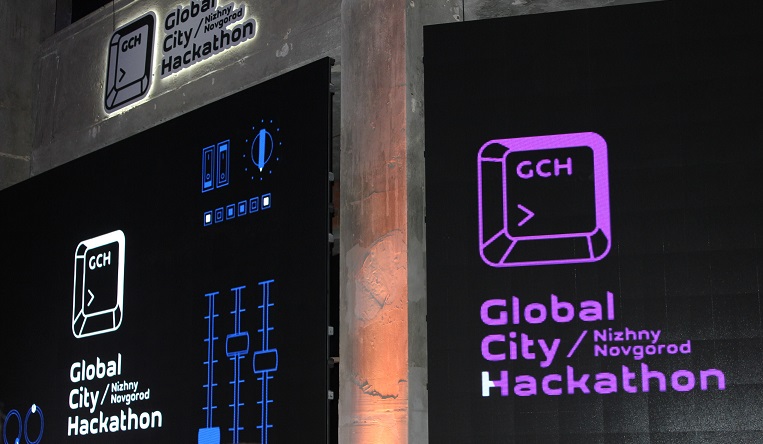
Carefully, there are photos that can drive off traffic (but this is not a photo story!)
April 19 - 21, 2019, the first Global City Hackathon was held in Nizhny Novgorod - a great event, for three days of which the developers, together with their teams, had to offer solutions in three categories.
')
They had no restrictions on the technologies used and the stack, no framework for creativity and flight of thought, no boundaries for the team structure - it was only 48 hours (someone worked at night) to create a solution and prepare a pitch. There were also experts who continuously advised the teams, helped prepare the presentations (as I understood, the organizers also took care of the template - because at the final pitches the slides were designed in the same style and had an almost perfect structure for the pitch).
The hackathon passed in the building of the former garment factory "Mayak" in a very cool and authentic atmosphere. The building is located on the banks of the Volga, opposite the Strelka - among other things, this is a very specific place with excellent air across the road: many participants went out to air, because the building was not hot, but rather noisy and tense.

Arrow view
Because our city is a huge IT cluster, in which many offices of IT companies with large tasks and good salaries are concentrated. Moreover, a whole layer of developers sits at home and their locations and work on major international projects such as, for example, SAP. I will not paint in detail, it was here , here and even in my announcement .
The governor of the Nizhny Novgorod region Gleb Nikitin told about the structure and revenues of IT companies in the panel discussion “Cities in the era of the fourth industrial revolution” (held inside the hakaton).
I quote from TASS: “ We have a good base for the development of integrated solutions (in the field of IT), which can be exported. An IT cluster has been created, which includes, among other things, international organizations, leaders in their industries. There are about 70 such companies There are about 300 IT companies in the region. The annual volume of their solutions is 26 billion rubles, about 80% of revenue is export, the code that is written for foreign partners . " I am sure that his words are as close to the truth as possible - moreover, I think that exports are even more, not all were counted :-)
The first day of the hackathon was the day of setting the tasks, introducing experts, greetings of the heads of the authorities, municipality and commercial structures. VEB, Rostelecom, Sberbank, RVK, GAS - these companies not only supported the participants, some of them presented their stands, and not with some sweets and booklets, but “to touch”. On the same day, the main lectures and thematic discussions were held, which helped the teams to direct their thoughts and ideas in the right direction - experts from around the world spoke. I managed to listen to some lectures online - they were really useful, a minimum of water, a maximum of experience and expertise (eeeh, I had to squeeze my laptop somewhere and stay!).
But the second and third day, as they say, through the eyes of an eyewitness with full immersion.
All day for the teams there were workshops with experts where they could discuss everything: from interface design to attracting investors. The teams managed the time very wisely: some of them worked with experts and at workshops, some sawed the code and did MVP (the prototypes will be lower - this is something).
In the main hall were performances, announced in the style of TED. I emphasize the word “claimed” because, according to my subjective feelings and my experience of listening to TED, only one of the speakers approached the style and spirit. The rest were somewhat divorced from reality - however, this is already a tediousness, it was great. I was impressed with the report by Natalia Seltsova, the Internet of Things Laboratory, Sberbank - a comprehensive and correct approach to IoT, not as a toy, but as a really applicable infrastructure. There is a lot to do, of course, first of all to grow in the user's mind, but this vision of an individual specialist says that IoT needs to be, it remains to find forms and integration.

But the most important was the third day - for the teams he was the most tense, literally wallowing from his feet. They had to complete work with their decisions, go through consultations with experts for a very limited time, present products (or, more precisely, prototypes) during pitch sessions in selected areas, and the best ones - once again present the solution at the final pitch session before the jury ( Just a second, including the mayor, the governor and the federal minister), experts and a whole room of visitors, participants, journalists (again there was no place to fall). This is a wild, almost unreal mode of operation in which you have two terrible enemies: time and nerves.
Now I will be the most subjective, because I looked at the decisions not through the eyes of a government representative or an investment expert, but through the eyes of a former engineer, tester — that is, I tried to understand how necessary it is in principle, how realizable and how much it is needed and realizable. .
The first to enter the scene was the Mixar team (the guys from the Nizhny Novgorod company of the same name, Mixar , the winners of all hackathons in computer vision for 2018 and 2019). The guys offered a prototype of the mobile application "Accessible City" for visually impaired people. The application is controlled by voice (with the help of Alice), helps build a route, takes a person to a stop and “meets” buses — recognizes the number of the approaching route and informs its owner that this is his bus. Then the application reports that they and the owner of the smartphone have reached the desired stop and it’s time to go. The visually impaired Ilya Lebedev took part in the development and testing of the application.
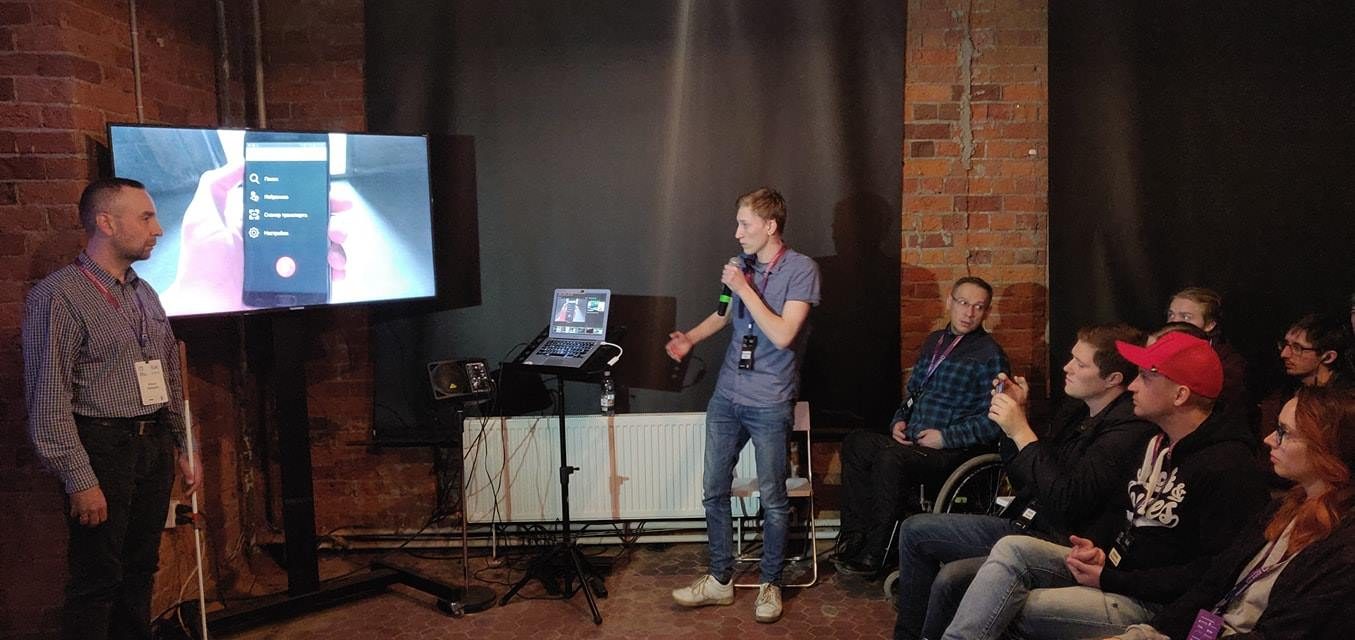
Team Mixar. Photos from the group Global City Hackathon on Facebook
The guys didn’t just show a prototype, but they made a video about how it works and the whole hall saw how Ilya set the route, reached the stop nearest to Mayak, and the application recognized first 45 and then the desired 40th route. It looked very simple and only engineers guessed what stack and how many neural networks was behind this application.
For me, it has become an application of the future: simple and reliable from the point of view of the interface, mobile, universal, easily scalable to any country, any language. It was obvious that the guys understand what they are doing, and they want it to work quickly, and not in some foggy run perspective. In a word, young people. For me it was the platinum pitch of the evening.
The second participant was announced by the moderator as a generally recognized leader, so after Mixar I was waiting for a bomb. However, the presentation itself was imbued with a not very correct message (we leave it on the author’s conscience), but the product is very interesting, a geolocation application of mutual assistance, “Help is Near.” The application should help to request and receive the necessary and competent assistance from people nearby, to gather a team and resources, if one does not cope. Naturally, it is aimed at getting system help. As the project developer is a marketer, he was particularly distinguished by the competent commercial part of the product, which in present conditions is very important for the growth of interest in your work (alas, not alas, this is a fact): every mutual assistance act in the application will take into account and social capital will be formed can be transformed into a loyalty program for companies. Also in the application is expected map of events, analytics, competitive moment by districts. With the help of neural networks and artificial intelligence, the author hopes to create the most secure application (you must admit, this is very important).
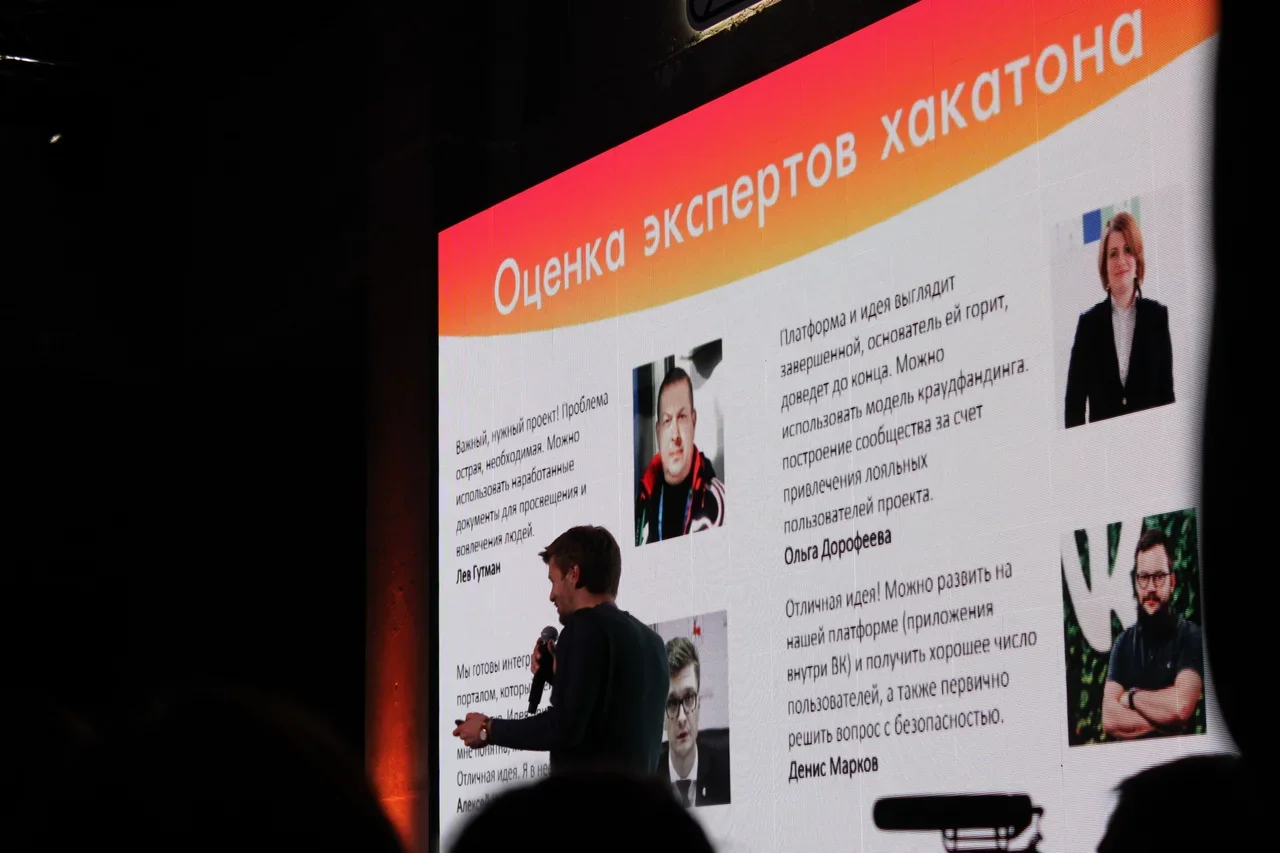
"Help is near" and the high assessment of experts
In this application, I was very pleased with the holistic approach, the opportunity to return to the social responsibility of business, the way to solve individual problems quickly, the emotional component (we are all a bit rescuers). From the point of view of the developer, I liked the idea of gamification - this is not the only conceived project with achivkas, but here the game and fascinating component is most obvious.
The prototype was not demonstrated, the mobile application for iOS and Android is announced as planned for the future.
The next pitch was dedicated to the nice and simple RECYCLECODE application, which should quickly provide people with information about the packaging of goods by its barcode. The person directs the camera, opened in the application, at the barcode, and sees what the packaging consists of and where the nearest collection point for this type of garbage is. The guys showed everyone a working prototype right on their mobile.
The project seems simple, but in fact it is quite resource-intensive, complex in terms of integrations and geolocation, it requires the work of users (who will fill in reference books) and the manufacturers themselves. It is clear that this story is not even tomorrow, but somewhat later, but if I were the mayor, I would have paid attention to this project and brought the city to the pilots in terms of environmental friendliness.
Another pitch was devoted to the problem of sewage. The same story - geolocation, management of vacuum trucks, proper allocation of resources, call of vacuum trucks to places where there is no sewage. The project received the pretty name "Senya" and fell in love with the mayor of Nizhny Novgorod, Vladimir Panov.
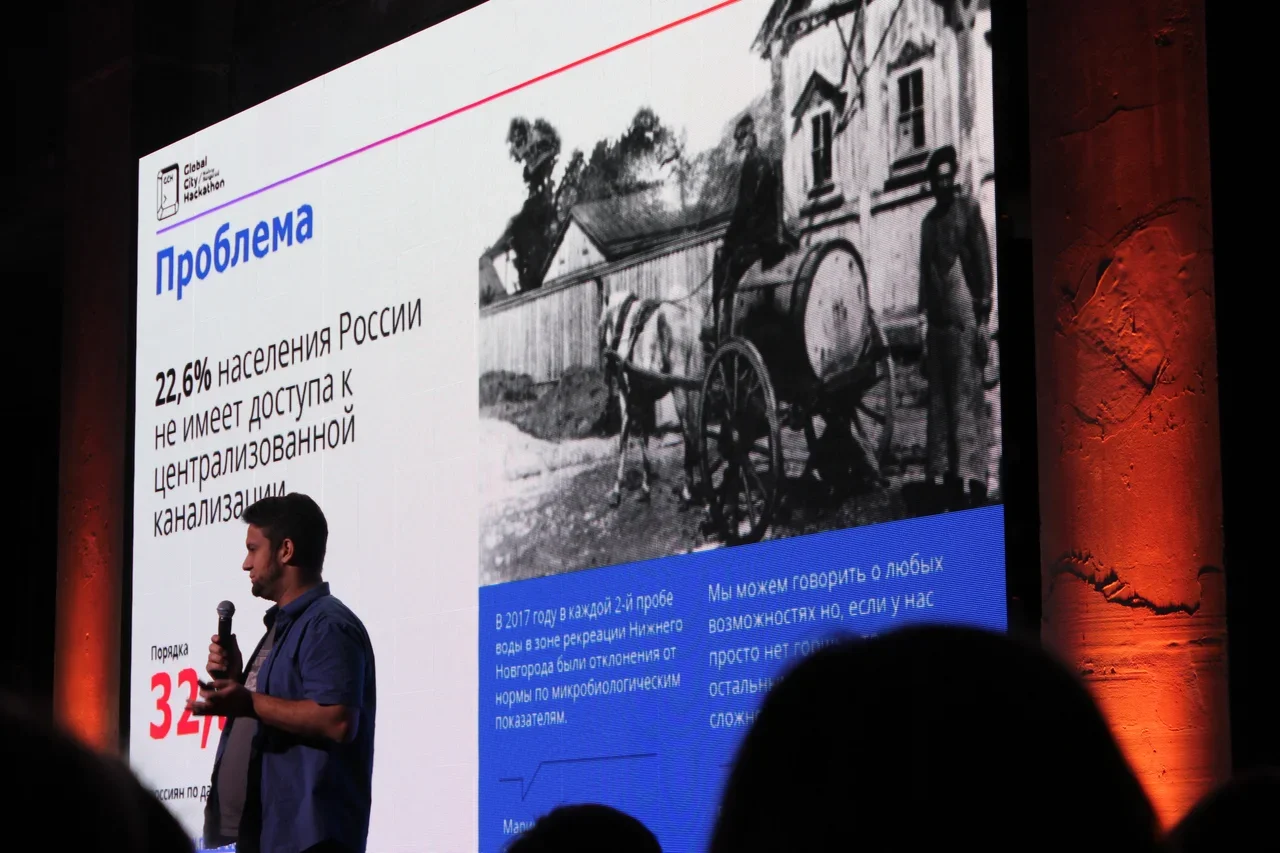
"Senya" and Co.
After the sewage system, the speakers returned to the garbage issues - and one of the winning projects was presented - # AntiMusor. This is a very complex system based on big data, designed to help manage the processes of collecting and transporting garbage, streamlining workflow and logistics, and effectively managing the fleet of garbage trucks.
The guys presented an amazing visualization of the prototype, where online you can track the routes of full and empty garbage trucks, as well as the fact of cleaning or filling garbage cans. It looked just cosmic :-) The system is actually a simulator of the process of collecting and transporting garbage with the possibility of dynamic route generation and analytics for further optimization of these processes.
The project looked very logical, architecturally verified and competently (the entire developed architecture of the project was presented by modules and functionality - but I will not lay out the slide, I would take this to classified information). There is no question about the benefits - the problem of garbage collection in large cities is one of the top priorities.
The most enduring project for me was the pitch “ParkingSim” by the guys from the Nizhny Novgorod architectural studio “DUTCH” on how to beat the parking hell. It was a difficult mixture of visualization, architectural design and development. And since nature rested on me, the child of two builders, my topographical cretinism howled in agony to the awareness of the prospects of the project.
In general, I will explain how an engineer - I hope the guys will not be offended. This application is a parking simulator in time in a specific geographic space. Relatively speaking, you put the car at the pharmacy, a neighbor from the third entrance - at the first, from the first - on the side of the road, etc. The system analyzes the time of parking and the distance from the residence (work) of the driver to his car, and proposes to develop a more logical option. And most importantly, it accumulates data that will allow architects of new residential complexes not to press windows into windows, but to intelligently plan the territory taking into account the requirements for parking spaces (including underground levels).
Separately, I will note the charismatic leader of the team, Cyril Pernatkin - it is so hot and burning speaker that you believe in him. Well, there is powerful professionalism, without a doubt.
From the track “Open City”, the guys came up with the project “Good city policeman” - a system of interaction with the authorities, allowing you to quickly and conveniently track the appeals of citizens, their character, geolocation and other information. This is an excellent example of the interaction of government and society in an open digital environment, where bureaucratic moments can be combined with a humane approach. The project reminded me of something “Angry Citizen” and something - the section of complaints in the State Services. In any case, such decisions are not superfluous.
The last project among the participants of the final pitch session was called “Socialest” from the team with the mysterious name Snogo / Begunok team. It was again a social interaction service, where inside the application you can find accomplices (and even better like-minded people) for good and useful things. The guys presented a prototype of the application, in which it was already possible to see the important points: through gamification, categories of activities (for example, volunteering or education), levels of "player", the application has interesting social goals: developing a state role, encouraging proactive residents, the base of such residents, the formation of a social community and may even enter the international level.
At the end of the pitches, the jury went to a short meeting. I stood close to them and tried to catch the winners - most of all I wanted to win Mixar, because this is the most important decision for some of the most unprotected - the visually impaired. The jury consisted of the Minister of Economic Development of the Russian Federation Maxim Oreshkin, the governor of the Nizhny Novgorod region Gleb Nikitin, the mayor of Nizhny Novgorod Vladimir Panov, the managing partner of the Philtech Initiative Alyona Svetushkova.
And ... ta da da da! Three projects will go to major European Smart City, where they will meet with local experts, representatives of municipalities and the IT community who have implemented major digital projects:
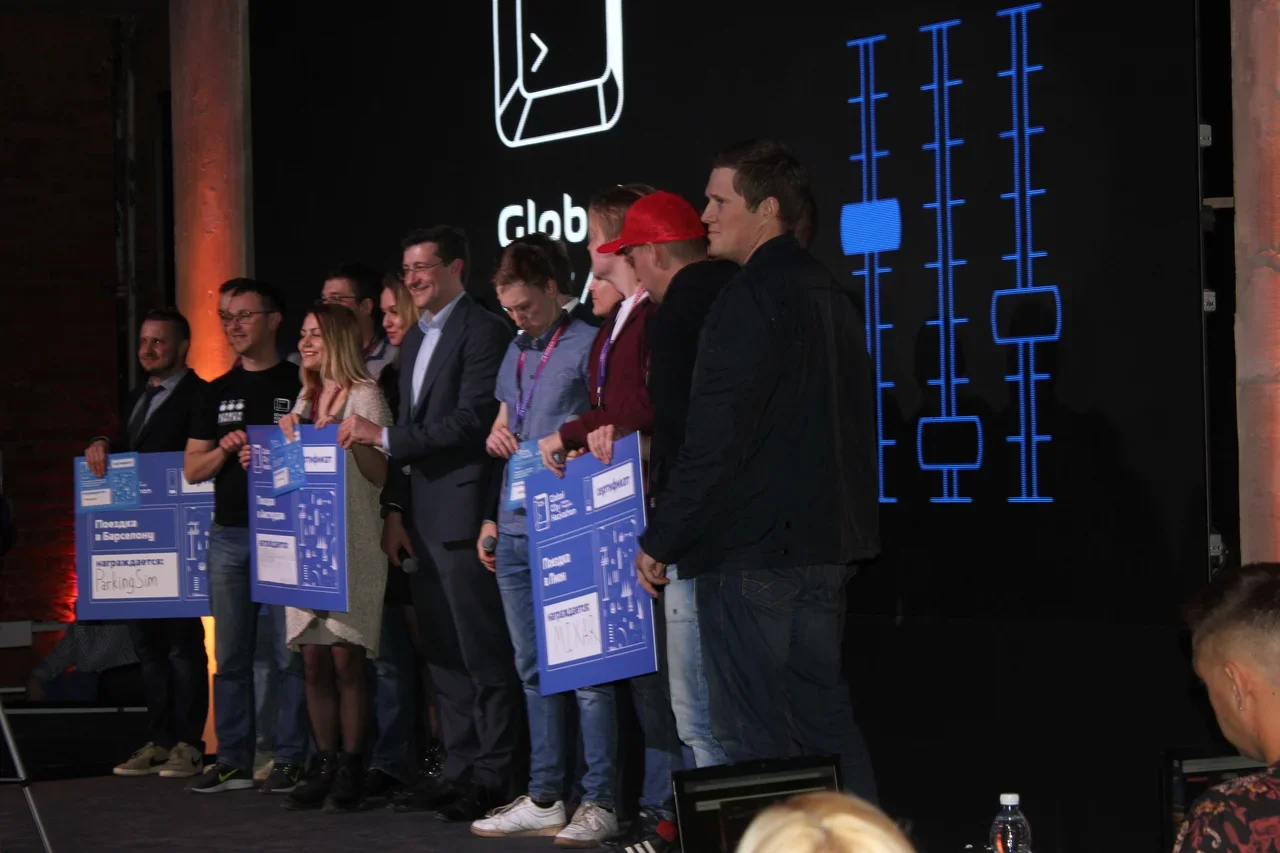
Winners!
Participants were also awarded with training courses, gifts from organizers and partners. As an avid Khabrovsk citizen, it was nice to see Skyeng courses (as they are for those who go abroad for meetings) and invitations to conferences from JUG.ru (the company was represented by Andrey Dmitriev and for the award - absolutely rightly - he chose Mixar, they will take the maximum from the conferences). Both companies have cool blogs on Habré.
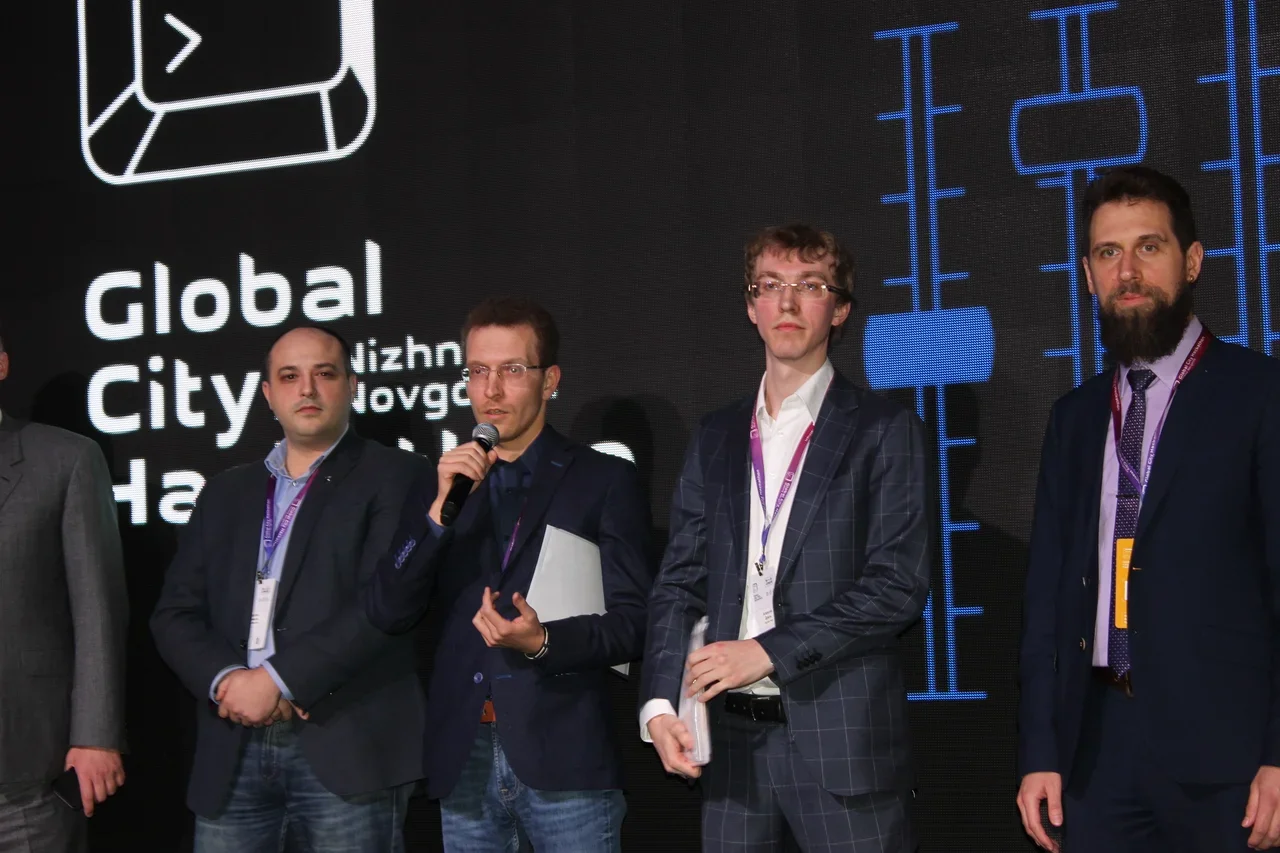
Experts and partners
The organization of the hackathon at all levels was practically without jambs, which is an incredible achievement for the first event in its class. Personally, I lacked a little water and space, but this is due to the huge flow of participants and just visitors and listeners of the hackathon. A huge plus is the broadcast from 360-cameras in social networks, this expanded coverage.

Teams focused
The lead of the main track, more precisely, the moderator of the open program, was Gene Kolesnikov from Singularity University, futurologist and visionary of artificial intelligence and robotics. He is so permeated with the topic of technology, apparently so fanatic that he managed to hide minor technical overlays and delays of parts of tracks behind philosophical and technical conversation. He was well oriented, joked and kept a rather scattered, noisy and versatile hall.

Gene and IT philosophy
For the hackathon Global City Hackathon, a special mobile application was developed with a description, program, partners, experts, a map - in general, everything a participant, expert, journalist, or such a curious listener like me might need. You could create your own program, get an alert about the imminent start of the desired track, see your activities in your personal account.
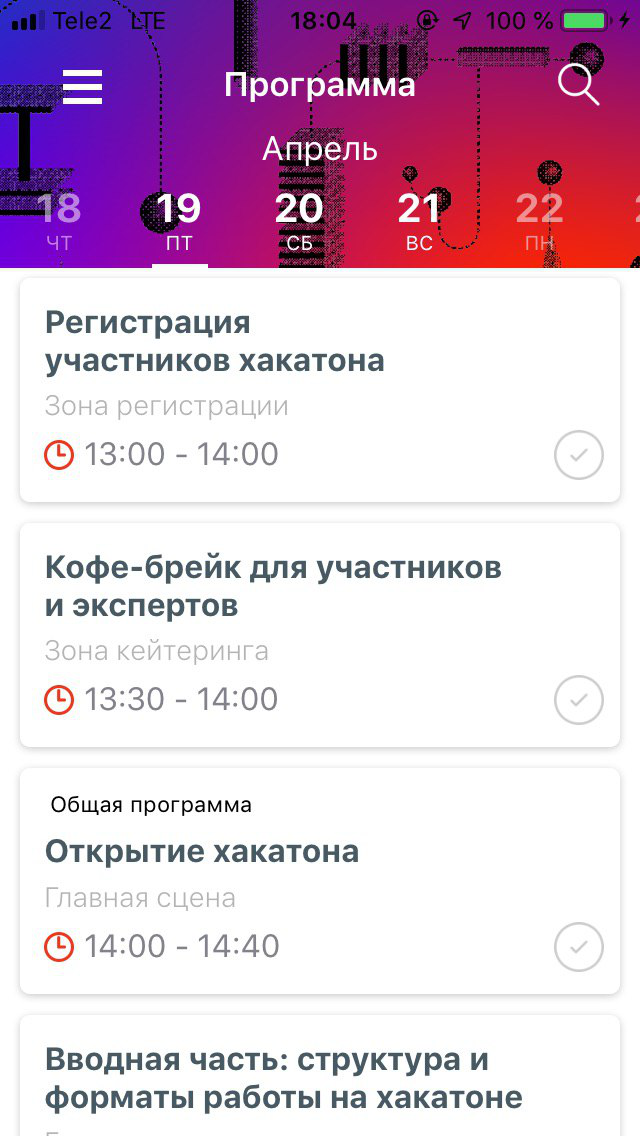

"Lighthouse" - a building of stunning beauty and grandeur, but inside, frankly, vintage and retro. The organizers made excellent lighting solutions - not cutting, but also interesting, hung cool posters on the walls. The result was a very warm and cozy loft atmosphere. And I even want the brick walls to always stick out like this, there would be an authentic staircase, dark aisles and the rest.

The ceiling of the main hall and the light on it

The wall opposite the toilet changed the lighting, but not the meaning :-)
They were at the booth of Rostelecom and near the stage. Anyone could come and appreciate what it is. There were many people who wanted to - the most courageous could not literally tear them away.
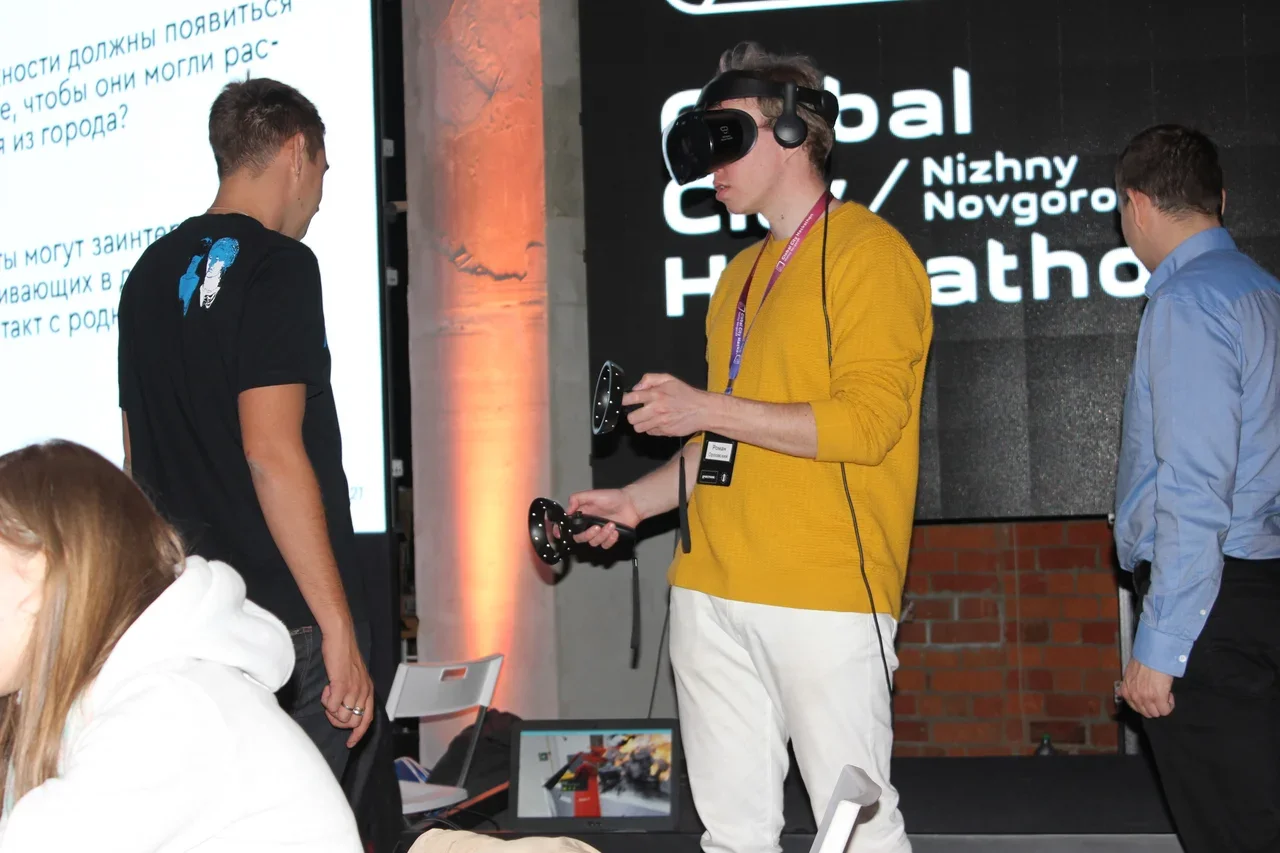
At the Sberbank stand, one could look at and touch the tiny branch of the bank, Rostelecom launched an interesting interactive touch screen with the latest smart achievements for life in the city. Sberbank could test the telemedicine docdoc system. The stern stand of GAZ OAO talked about intelligent solutions for driving and driving cars. The coolest was the SAROVA water stand, where you could grab a bottle, and at the bottom in two rows the kinescope televisions reminded you of what technological gap between the recent past and the real present.

Stand Rostelecom

It was the only chance to steal an ATM
The authorities were at the hackathon all three days, communicated, joked, attentively treated almost every project presented. It was unexpected and quite inspiring - the real, genuine interest of the governor and the mayor was felt. At the same time, everyone walked quite calmly, didn’t push anyone and didn’t scrub security, there was a full partnership atmosphere. I had to see a formalized, dictated attitude “on a piece of paper,” so such changes could not please me as a specialist and as a resident of Nizhny Novgorod.
In principle, ready-made teams come to the hackathon, who are united, with an idea, somewhere even with MVP. Therefore, many are embarrassed to come to the hakathons and take part. However, there were teams that gathered on Friday right on the court, and on Sunday they had already presented a project at their pitch sessions. One of these was the Privet! NN project team, who came up with the idea of a platform for connecting guides and tourists. By the way, Rostelecom called this project one of the most quickly implemented. In addition, in 2021, Nizhny Novgorod is 800 years old - there will be demand. So, do not be afraid to create teams and offer ideas. Moreover, participation in hackathons is both career opportunities, investments and even public relations of your company.

Part of the Privet team! NN
, , . , , , , . , , Global City Hackathon, « , - ».
.

—
, , 24 — — - «-» :-)
Usually, articles about hackathons on Habré are not particularly interesting: small meetings to solve narrow problems, professional discussions within a single technology, corporate sessions. Actually, it was on such hackathons that I had to be. Therefore, looking at the Global City Hackathon site on Friday, I ... had to leave for my office. Though I have a remote, but very dense and loaded work, so I reasoned something like this: I will come there, there are many tables, I will stick with the laptop, I will work, and with one ear and an eye follow what is happening. There was no place - in general, neither on the tables, nor on the chairs, nor on the lintel at some iron shit, or even on the sofas behind the stands. It immediately became clear that this is hackathon ++. Well, I went to him on Saturday and Sunday - and did not regret it. Who with me - I ask under kat.

Carefully, there are photos that can drive off traffic (but this is not a photo story!)
A bit of background
April 19 - 21, 2019, the first Global City Hackathon was held in Nizhny Novgorod - a great event, for three days of which the developers, together with their teams, had to offer solutions in three categories.
')
- Accessible City - proposals for the development of an accessible urban environment, including for people with limited mobility, support for the elderly and people with disabilities. This is a very important category, if only because each of us at some point may be among such citizens: having been injured or fractured, in the last stages of pregnancy, with three children and a sidecar, etc. - that is, in situations where the help of other people and some additional, thoughtful convenience are needed.
- Wasteless city. The transition to a closed loop economy. Efficiency and transparency of work on the collection, removal and disposal of garbage, reuse of resources, environmental monitoring, environmental education. I’m not lying if I say that this is an important story “from Moscow to the very outskirts”, because we generate garbage nemerye (hi, polyethylene, bottles, packaging, etc.), we experience problems with both solid household waste and with sewage, especially in the countryside and the suburbs (I can a hundred times decently call a vacuum truck to pump the septic tank at the dacha, but I cannot bear any responsibility for where it throws off, and the precedents are very unpleasant).
- Open city. The collection, storage, processing and provision of data to meet the needs of urban services, the business community, citizens and tourists. At first glance, the story is not as important and burning as the previous two, but in fact, this includes issues of volunteering, housing and public utilities management, dialogue with the authorities, and public relations. It is as if the information shell, the base, the basis of all other issues.
They had no restrictions on the technologies used and the stack, no framework for creativity and flight of thought, no boundaries for the team structure - it was only 48 hours (someone worked at night) to create a solution and prepare a pitch. There were also experts who continuously advised the teams, helped prepare the presentations (as I understood, the organizers also took care of the template - because at the final pitches the slides were designed in the same style and had an almost perfect structure for the pitch).
The hackathon passed in the building of the former garment factory "Mayak" in a very cool and authentic atmosphere. The building is located on the banks of the Volga, opposite the Strelka - among other things, this is a very specific place with excellent air across the road: many participants went out to air, because the building was not hot, but rather noisy and tense.

Arrow view
Short facts
- Global City Hackathon is an initiative of the Council on the global agenda of the future for Russia of the World Economic Forum.
- Project organizers in Nizhny Novgorod: the regional government, the city administration, VEB RF, Strategy Partners and the Philtech Initiative.
- The project is being implemented in partnership with Sberbank, Rostelecom, RVC, the Industry Development Fund, the Russian Export Center and with the support of Promsvyazbank.
- Nizhny Novgorod became the first city in Russia where Global City Hackathon was held.
Why Nizhny Novgorod?
Because our city is a huge IT cluster, in which many offices of IT companies with large tasks and good salaries are concentrated. Moreover, a whole layer of developers sits at home and their locations and work on major international projects such as, for example, SAP. I will not paint in detail, it was here , here and even in my announcement .
The governor of the Nizhny Novgorod region Gleb Nikitin told about the structure and revenues of IT companies in the panel discussion “Cities in the era of the fourth industrial revolution” (held inside the hakaton).
I quote from TASS: “ We have a good base for the development of integrated solutions (in the field of IT), which can be exported. An IT cluster has been created, which includes, among other things, international organizations, leaders in their industries. There are about 70 such companies There are about 300 IT companies in the region. The annual volume of their solutions is 26 billion rubles, about 80% of revenue is export, the code that is written for foreign partners . " I am sure that his words are as close to the truth as possible - moreover, I think that exports are even more, not all were counted :-)
Three days that can turn the world around
The first day of the hackathon was the day of setting the tasks, introducing experts, greetings of the heads of the authorities, municipality and commercial structures. VEB, Rostelecom, Sberbank, RVK, GAS - these companies not only supported the participants, some of them presented their stands, and not with some sweets and booklets, but “to touch”. On the same day, the main lectures and thematic discussions were held, which helped the teams to direct their thoughts and ideas in the right direction - experts from around the world spoke. I managed to listen to some lectures online - they were really useful, a minimum of water, a maximum of experience and expertise (eeeh, I had to squeeze my laptop somewhere and stay!).
But the second and third day, as they say, through the eyes of an eyewitness with full immersion.
All day for the teams there were workshops with experts where they could discuss everything: from interface design to attracting investors. The teams managed the time very wisely: some of them worked with experts and at workshops, some sawed the code and did MVP (the prototypes will be lower - this is something).
In the main hall were performances, announced in the style of TED. I emphasize the word “claimed” because, according to my subjective feelings and my experience of listening to TED, only one of the speakers approached the style and spirit. The rest were somewhat divorced from reality - however, this is already a tediousness, it was great. I was impressed with the report by Natalia Seltsova, the Internet of Things Laboratory, Sberbank - a comprehensive and correct approach to IoT, not as a toy, but as a really applicable infrastructure. There is a lot to do, of course, first of all to grow in the user's mind, but this vision of an individual specialist says that IoT needs to be, it remains to find forms and integration.

But the most important was the third day - for the teams he was the most tense, literally wallowing from his feet. They had to complete work with their decisions, go through consultations with experts for a very limited time, present products (or, more precisely, prototypes) during pitch sessions in selected areas, and the best ones - once again present the solution at the final pitch session before the jury ( Just a second, including the mayor, the governor and the federal minister), experts and a whole room of visitors, participants, journalists (again there was no place to fall). This is a wild, almost unreal mode of operation in which you have two terrible enemies: time and nerves.
Final, pitches and fear for the winner
Now I will be the most subjective, because I looked at the decisions not through the eyes of a government representative or an investment expert, but through the eyes of a former engineer, tester — that is, I tried to understand how necessary it is in principle, how realizable and how much it is needed and realizable. .
The first to enter the scene was the Mixar team (the guys from the Nizhny Novgorod company of the same name, Mixar , the winners of all hackathons in computer vision for 2018 and 2019). The guys offered a prototype of the mobile application "Accessible City" for visually impaired people. The application is controlled by voice (with the help of Alice), helps build a route, takes a person to a stop and “meets” buses — recognizes the number of the approaching route and informs its owner that this is his bus. Then the application reports that they and the owner of the smartphone have reached the desired stop and it’s time to go. The visually impaired Ilya Lebedev took part in the development and testing of the application.

Team Mixar. Photos from the group Global City Hackathon on Facebook
Excerpt from the presentation (the slides are overexposed, therefore I quote from them):
In Russia, a huge number of people with congenital or acquired blindness and the visually impaired: the blind are 300,000, the visually impaired are 2.5 million. They actively use smartphones, because for such people this is an important way to contact the world. It is believed that when landing in public transport, the blind person experiences the same stress as the pilot of a passenger airliner during an emergency landing.
In St. Petersburg, there is a “Talking City” system, but the cost of equipment in one city is 1.5 billion rubles, the system confuses oncoming and passing buses, and one subscriber unit costs 15,000 rubles. In addition, "Talking City" does not work with all vehicles and is not available to non-residents.
The system, developed by the team, does not require any additional equipment, is 2000 times cheaper than analogs, works with any transport in any language, does not require an internet connection and a database.
The guys didn’t just show a prototype, but they made a video about how it works and the whole hall saw how Ilya set the route, reached the stop nearest to Mayak, and the application recognized first 45 and then the desired 40th route. It looked very simple and only engineers guessed what stack and how many neural networks was behind this application.
For me, it has become an application of the future: simple and reliable from the point of view of the interface, mobile, universal, easily scalable to any country, any language. It was obvious that the guys understand what they are doing, and they want it to work quickly, and not in some foggy run perspective. In a word, young people. For me it was the platinum pitch of the evening.
The second participant was announced by the moderator as a generally recognized leader, so after Mixar I was waiting for a bomb. However, the presentation itself was imbued with a not very correct message (we leave it on the author’s conscience), but the product is very interesting, a geolocation application of mutual assistance, “Help is Near.” The application should help to request and receive the necessary and competent assistance from people nearby, to gather a team and resources, if one does not cope. Naturally, it is aimed at getting system help. As the project developer is a marketer, he was particularly distinguished by the competent commercial part of the product, which in present conditions is very important for the growth of interest in your work (alas, not alas, this is a fact): every mutual assistance act in the application will take into account and social capital will be formed can be transformed into a loyalty program for companies. Also in the application is expected map of events, analytics, competitive moment by districts. With the help of neural networks and artificial intelligence, the author hopes to create the most secure application (you must admit, this is very important).

"Help is near" and the high assessment of experts
Quote from the presentation:
Every third resident of the Nizhny Novgorod region needs regular help from those around him due to the limitations of the city infrastructure. This is a serious burden on social services: people with disabilities, 300 thousand are lonely and elderly people, 120 thousand are mothers with children under 4 years old, 200 thousand are people with time constraints.
In this application, I was very pleased with the holistic approach, the opportunity to return to the social responsibility of business, the way to solve individual problems quickly, the emotional component (we are all a bit rescuers). From the point of view of the developer, I liked the idea of gamification - this is not the only conceived project with achivkas, but here the game and fascinating component is most obvious.
The prototype was not demonstrated, the mobile application for iOS and Android is announced as planned for the future.
The next pitch was dedicated to the nice and simple RECYCLECODE application, which should quickly provide people with information about the packaging of goods by its barcode. The person directs the camera, opened in the application, at the barcode, and sees what the packaging consists of and where the nearest collection point for this type of garbage is. The guys showed everyone a working prototype right on their mobile.
The project seems simple, but in fact it is quite resource-intensive, complex in terms of integrations and geolocation, it requires the work of users (who will fill in reference books) and the manufacturers themselves. It is clear that this story is not even tomorrow, but somewhat later, but if I were the mayor, I would have paid attention to this project and brought the city to the pilots in terms of environmental friendliness.
Quote from the presentation:
There are few recyclables in Russia, many dumps: 99.6% of waste is processed in Germany, 93% in France, 52% in Italy, 60% on average in the European Union, and 5-7% in Russia. People do not know which packaging can be recycled, which means the labeling on the packaging, where the waste collection points are located.
Another pitch was devoted to the problem of sewage. The same story - geolocation, management of vacuum trucks, proper allocation of resources, call of vacuum trucks to places where there is no sewage. The project received the pretty name "Senya" and fell in love with the mayor of Nizhny Novgorod, Vladimir Panov.

"Senya" and Co.
Quote from the presentation:
22.6% of Russia's population does not have access to centralized sewage. In 2017, in every second water sample in the Nizhny Novgorod recreation zone there were deviations from the norm in terms of microbiological indicators.
We can talk about any possibilities, but if we simply do not have a pot, then there will be great difficulties with everything else.
- Director of the Water Supply Association of Russia
After the sewage system, the speakers returned to the garbage issues - and one of the winning projects was presented - # AntiMusor. This is a very complex system based on big data, designed to help manage the processes of collecting and transporting garbage, streamlining workflow and logistics, and effectively managing the fleet of garbage trucks.
The guys presented an amazing visualization of the prototype, where online you can track the routes of full and empty garbage trucks, as well as the fact of cleaning or filling garbage cans. It looked just cosmic :-) The system is actually a simulator of the process of collecting and transporting garbage with the possibility of dynamic route generation and analytics for further optimization of these processes.
The project looked very logical, architecturally verified and competently (the entire developed architecture of the project was presented by modules and functionality - but I will not lay out the slide, I would take this to classified information). There is no question about the benefits - the problem of garbage collection in large cities is one of the top priorities.
The most enduring project for me was the pitch “ParkingSim” by the guys from the Nizhny Novgorod architectural studio “DUTCH” on how to beat the parking hell. It was a difficult mixture of visualization, architectural design and development. And since nature rested on me, the child of two builders, my topographical cretinism howled in agony to the awareness of the prospects of the project.
In general, I will explain how an engineer - I hope the guys will not be offended. This application is a parking simulator in time in a specific geographic space. Relatively speaking, you put the car at the pharmacy, a neighbor from the third entrance - at the first, from the first - on the side of the road, etc. The system analyzes the time of parking and the distance from the residence (work) of the driver to his car, and proposes to develop a more logical option. And most importantly, it accumulates data that will allow architects of new residential complexes not to press windows into windows, but to intelligently plan the territory taking into account the requirements for parking spaces (including underground levels).
Separately, I will note the charismatic leader of the team, Cyril Pernatkin - it is so hot and burning speaker that you believe in him. Well, there is powerful professionalism, without a doubt.
From the track “Open City”, the guys came up with the project “Good city policeman” - a system of interaction with the authorities, allowing you to quickly and conveniently track the appeals of citizens, their character, geolocation and other information. This is an excellent example of the interaction of government and society in an open digital environment, where bureaucratic moments can be combined with a humane approach. The project reminded me of something “Angry Citizen” and something - the section of complaints in the State Services. In any case, such decisions are not superfluous.
The last project among the participants of the final pitch session was called “Socialest” from the team with the mysterious name Snogo / Begunok team. It was again a social interaction service, where inside the application you can find accomplices (and even better like-minded people) for good and useful things. The guys presented a prototype of the application, in which it was already possible to see the important points: through gamification, categories of activities (for example, volunteering or education), levels of "player", the application has interesting social goals: developing a state role, encouraging proactive residents, the base of such residents, the formation of a social community and may even enter the international level.
At the end of the pitches, the jury went to a short meeting. I stood close to them and tried to catch the winners - most of all I wanted to win Mixar, because this is the most important decision for some of the most unprotected - the visually impaired. The jury consisted of the Minister of Economic Development of the Russian Federation Maxim Oreshkin, the governor of the Nizhny Novgorod region Gleb Nikitin, the mayor of Nizhny Novgorod Vladimir Panov, the managing partner of the Philtech Initiative Alyona Svetushkova.
And ... ta da da da! Three projects will go to major European Smart City, where they will meet with local experts, representatives of municipalities and the IT community who have implemented major digital projects:
- Track Available City - Mixar team will go to Lyon.
- Track Waste-free city - team # Antimusor will go to Amsterdam.
- Track Open City - the ParkingSim team will go to Barcelona.

Winners!
Participants were also awarded with training courses, gifts from organizers and partners. As an avid Khabrovsk citizen, it was nice to see Skyeng courses (as they are for those who go abroad for meetings) and invitations to conferences from JUG.ru (the company was represented by Andrey Dmitriev and for the award - absolutely rightly - he chose Mixar, they will take the maximum from the conferences). Both companies have cool blogs on Habré.

Experts and partners
Facts about the hackathon that surprised, pleased, disappointed
Organization
The organization of the hackathon at all levels was practically without jambs, which is an incredible achievement for the first event in its class. Personally, I lacked a little water and space, but this is due to the huge flow of participants and just visitors and listeners of the hackathon. A huge plus is the broadcast from 360-cameras in social networks, this expanded coverage.

Teams focused
Leading
The lead of the main track, more precisely, the moderator of the open program, was Gene Kolesnikov from Singularity University, futurologist and visionary of artificial intelligence and robotics. He is so permeated with the topic of technology, apparently so fanatic that he managed to hide minor technical overlays and delays of parts of tracks behind philosophical and technical conversation. He was well oriented, joked and kept a rather scattered, noisy and versatile hall.

Gene and IT philosophy
Mobile app
For the hackathon Global City Hackathon, a special mobile application was developed with a description, program, partners, experts, a map - in general, everything a participant, expert, journalist, or such a curious listener like me might need. You could create your own program, get an alert about the imminent start of the desired track, see your activities in your personal account.


Light and walls
"Lighthouse" - a building of stunning beauty and grandeur, but inside, frankly, vintage and retro. The organizers made excellent lighting solutions - not cutting, but also interesting, hung cool posters on the walls. The result was a very warm and cozy loft atmosphere. And I even want the brick walls to always stick out like this, there would be an authentic staircase, dark aisles and the rest.

The ceiling of the main hall and the light on it

The wall opposite the toilet changed the lighting, but not the meaning :-)
Virtual reality glasses
They were at the booth of Rostelecom and near the stage. Anyone could come and appreciate what it is. There were many people who wanted to - the most courageous could not literally tear them away.

Company stands
At the Sberbank stand, one could look at and touch the tiny branch of the bank, Rostelecom launched an interesting interactive touch screen with the latest smart achievements for life in the city. Sberbank could test the telemedicine docdoc system. The stern stand of GAZ OAO talked about intelligent solutions for driving and driving cars. The coolest was the SAROVA water stand, where you could grab a bottle, and at the bottom in two rows the kinescope televisions reminded you of what technological gap between the recent past and the real present.

Stand Rostelecom

It was the only chance to steal an ATM
Dialogue of the authorities and participants
The authorities were at the hackathon all three days, communicated, joked, attentively treated almost every project presented. It was unexpected and quite inspiring - the real, genuine interest of the governor and the mayor was felt. At the same time, everyone walked quite calmly, didn’t push anyone and didn’t scrub security, there was a full partnership atmosphere. I had to see a formalized, dictated attitude “on a piece of paper,” so such changes could not please me as a specialist and as a resident of Nizhny Novgorod.
Interesting teams
In principle, ready-made teams come to the hackathon, who are united, with an idea, somewhere even with MVP. Therefore, many are embarrassed to come to the hakathons and take part. However, there were teams that gathered on Friday right on the court, and on Sunday they had already presented a project at their pitch sessions. One of these was the Privet! NN project team, who came up with the idea of a platform for connecting guides and tourists. By the way, Rostelecom called this project one of the most quickly implemented. In addition, in 2021, Nizhny Novgorod is 800 years old - there will be demand. So, do not be afraid to create teams and offer ideas. Moreover, participation in hackathons is both career opportunities, investments and even public relations of your company.

Part of the Privet team! NN
, , . , , , , . , , Global City Hackathon, « , - ».
.

—
it52.info , IT ( - ).
, , 24 — — - «-» :-)
Source: https://habr.com/ru/post/449050/
All Articles